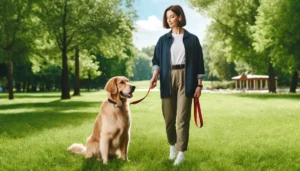When teaching a dog, the way you do things can have a big impact on his performance. Positive dog training is becoming increasingly popular because it is effective and dog-friendly. In this way, treats can be used to reinforce good behavior, helping owners and dogs develop a close bond. This article discusses the ideas and methods behind positive dog training and how it can help you build a happy and successful relationship with your dog.
Table of Contents
ToggleUnderstanding Positive Dog Training:
Positive dog training is based on the science of behaviorism, which states that it is better to reward good behavior than to punish bad behavior. It’s important to reward your dog when he does what you want him to do, to strengthen the link between action and a good outcome.
Positive feedback can take many forms, such as toys, treats, praise, or even just playtime. The goal is for the dog to enjoy learning so that he develops a good association with the desired behavior.
Positive Dog Training has the Following Benefits:
- Strengthens trust and bond: Good dog training can ensure that you and your canine friend trust each other. By using treats and positive feedback, you can make training your dog fun, strengthening the bond between the two of you.
- Encourage mental stimulation: When you train your dog properly, it will be mentally stimulated. This is especially important for smart dog breeds, as mental training is important for a happy and healthy dog.
- Troubleshooting: Positive training will not make your dog anxious; Instead, it makes them think and come up with solutions to problems. This not only helps with learning certain behaviors, it also makes the dog more flexible and better able to learn in new situations.
- Teaching Stress and Anxiety: Training dogs harshly can leave them feeling stressed and anxious. Positive reinforcement, on the other hand, can create a supportive environment that reduces the likelihood of anxiety-related problems.
Rules for Positively Training Your Dog:
- Timing is very important: Timing is very important when it comes to teaching your dog properly. Rewards should be given immediately after the action you want to see. This helps your dog associate the behavior with the treat, reinforcing it.
- Consistency: It is important to be consistent when teaching your dog properly. Make sure everyone knows what is expected of him or her, and always praise good behavior while ignoring or correcting bad behavior. This allows your dog to know what you want him to do.
- Use high-quality rewards: Different rewards drive different dogs. Try giving your dog different treats, toys, and praise to see what he likes best. Using valuable treats will keep your dog interested and motivated during training.
- Gradual progression: Divide training efforts into smaller steps that are easier to manage. As you progress from simple tasks to more difficult ones, make sure your dog understands each task before moving on. This method can give your dog confidence and help him behave better.
- Patience and a good attitude: Training a dog properly takes time. Dogs may not understand something right away, so be patient and stay in a good mood. Enjoy the small victories and progress at a pace that suits your dog’s learning style.
Useful Tips for Active Training:
- Clicker training: With clicker training, you use a clicker to indicate the exact moment your dog does what you want him to do, and then reward him. This approach is excellent for focusing and encouraging concrete action.
- Lures and rewards: To get your dog to do or place something you want, you can use treats or toys. Once your dog has followed the temptation, give him the treat. You can use this method to teach commands such as ‘sit’, ‘down’, or ‘roll over’.
- Record and reward: Record the number of times your dog easily does what you want him to do, and reward him immediately. This method is great for rewarding behaviors that aren’t always easy to obtain, such as staying calm or paying attention.
- Use positive reinforcement in everyday life: Positive reinforcement should be part of your daily interactions with your dog. Reward them when they stay calm, follow your instructions, or exhibit good behavior. When you constantly praise people, they learn that this behavior is normal.
Conclusion
Positive dog training is an effective and ethical way to strengthen the bond between you and your dog. If you focus on positive reinforcement, stability, and patience, it is possible to change your dog’s behavior. Remember that training is a continuous process that requires effort and a good mood. If you use the right methods and adopt the right attitude, you can build a great relationship with your furry friend based on trust, respect, and happiness.
FAQs
1. What does ‘positive dog training’ mean?
This method of dog training is based on positive reinforcement, which means that rewards, praise, and play are used to support good behavior rather than punish bad behavior.
2. Why is positive dog training a good idea?
Positively training your dog will build confidence, keep the mind active, help you solve problems, and reduce your stress and worries. It creates a great learning space and strengthens the bond between the dog and the owner.
3. What are positive rewards? How does it help with dog training?
When you use positive reinforcement, you reward your dog immediately after he does something you want him to do. This creates a good connection with the action, making it more likely to happen again.
4. What are the most important rules for good dog training?
Some of the most important rules are: give rewards at the right time, be clear about your expectations, use high-quality rewards, make training tasks more difficult over time, and be patient and enjoyable throughout the process.
5. How important is timing when teaching a dog the right way?
Timing is very important in good dog training. To strengthen the link between actions and good outcomes, rewards should be given immediately after the desired behavior.
6. Why are high-value rewards important?
For your dog, valuable benefits are things that are important to him, such as treats, toys, or praise. Using these treats as a reward will keep your dog interested and motivated during training.


